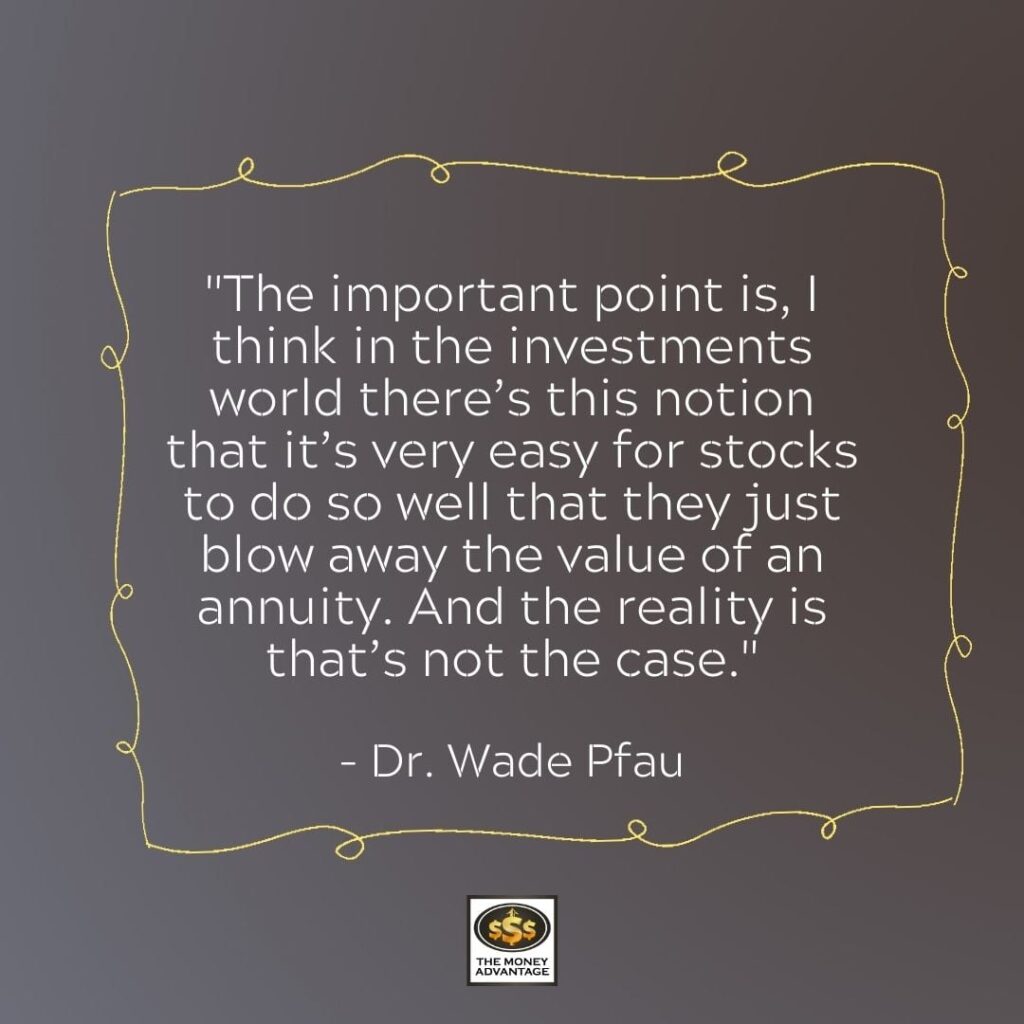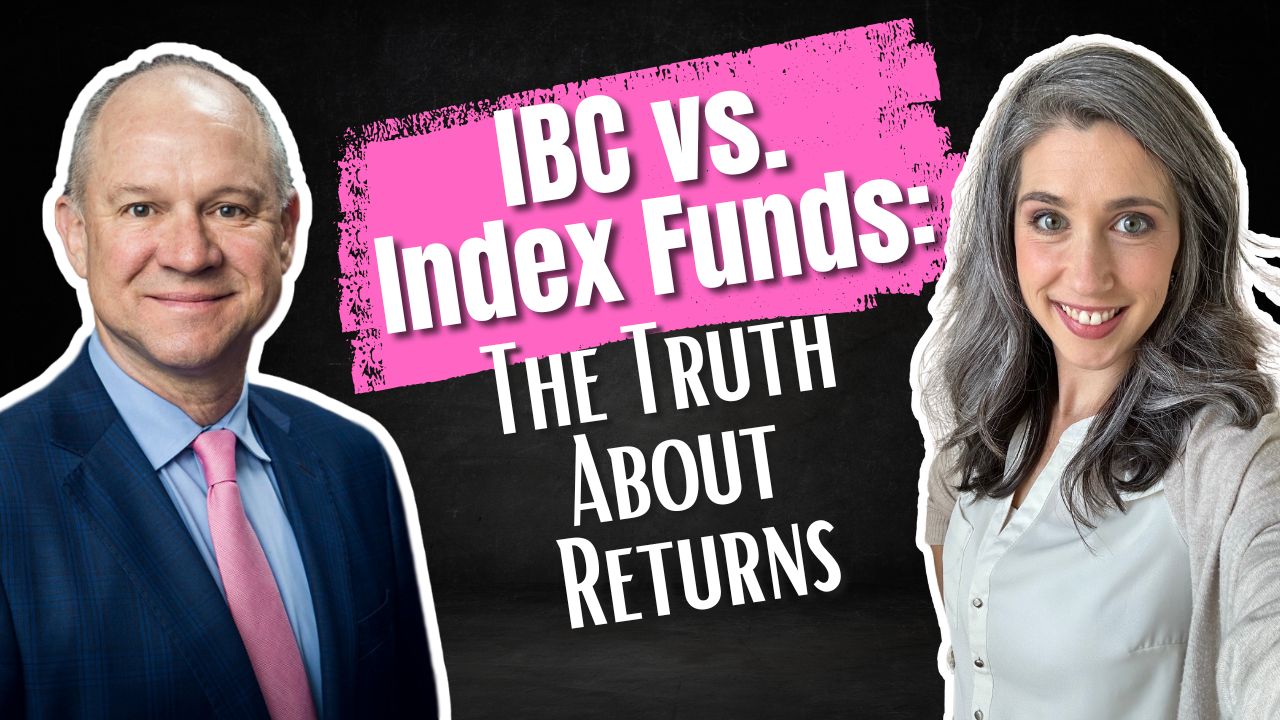
3 Benefits of Whole Life Insurance in Your Retirement Plan, with Dr. Wade Pfau
Most people don’t see the need for life insurance in their later years, let alone the benefit of whole life insurance in their retirement plan. By retirement, you may expect to have your home paid off, and not have the same income needs as before. You may even decide you’re not retiring at all if you can help it.
Even still, there are tremendous advantages to whole life insurance that lasts for your whole life. This includes having insurance beyond what most consider their life insurance needs. For many people, retirement planning with whole life insurance isn’t just about protection – it’s also a way to build reliable retirement savings that complement other income sources.
Tune in today for this eye-opening conversation with Dr. Wade Pfau about the three key benefits of retirement planning with whole life insurance.
Podcast: Play in new window | Download (Duration: 1:01:22 — 70.2MB)
Subscribe: Apple Podcasts | Spotify | Android | Pandora | Youtube Music | RSS | More
Table of contents
The Nature of Retirement Income
[5:19] “What makes retirement income different is that the nature of risk changes… just in looking at how the investment world approached retirement income, I developed concerns.”
Those concerns led to Dr. Pfau looking into assets that are traditionally not considered retirement assets, like life insurance. Life insurance isn’t common in retirement plans because many people don’t believe they need it anymore. However, life insurance has benefits that many people don’t consider, and aren’t taught to consider.
[5:56] “In the risk management context of retirement… potentially looking at different tools, not just using only an investment portfolio to fund retirement expenses, can help lay that foundation for a better retirement outcome.”
When you only have investment assets for retirement, you have a sequence of returns risk. This means that you risk significant losses because you can’t time the market in retirement. After all, you’ve got to take your income to eat and pay bills.
Retirement income usually comes from several sources, including social security, pensions, investment withdrawals, and whole life insurance retirement income. Balancing these streams helps reduce risk and creates a more predictable cash flow in retirement.
The Benefits of Whole Life Insurance in Your Retirement Plan
The value of whole life insurance is that “the cash value is not exposed to the risk of loss,” as Wade says. The cash value is a non-correlated asset and grows no matter what is going on in the stock market.
[7:25] “It can provide a resource to cover spending on a temporary basis during this kind of bad market environment so that you don’t have to sell from the portfolio to fund spending… Well, then that gives the portfolio an opportunity to recover and to make up those losses again before we have to go back to selling from it.”
[8:01] “Ultimately the benefits [of whole life insurance] to the portfolio exceed the cost of the insurance to give a better net outcome, especially when we consider the tax advantages and so forth of life insurance.”
Some of the key benefits of whole life insurance in your retirement plan include:
- Guaranteed cash value growth that isn’t tied to market swings
- Tax-free access to funds through policy loans
- A death benefit that supports long-term legacy planning
- Protection against market volatility by acting as a non-correlated asset
How Does the Volatility Buffer Work?
A “volatility buffer,” as Wade Pfau calls it, is an asset that can help your investments during market downturns. The idea is that after the market dips, you can pull income from your volatility buffer to minimize your losses and give the account time to recover. When you give your investments some breathing room, you can extend the life of your investment account by years.
An ideal asset for a volatility buffer is whole life insurance because it’s flexible and liquid. Not to mention, the death benefit provides some protection for your estate and assets. Whole life insurance gives you some freedom to spend without disinheriting heirs, too.
For example, instead of selling investments after a 20% market drop, a retiree could draw from whole life insurance policy loans to cover living expenses. Once the market recovers, they can resume withdrawals from their investment portfolio, thereby preserving growth potential and avoiding losses.
Inflation Risks
In conversations about retirement, people often ignore the impact of inflation. The harsh truth is that due to inflation, you will need more money in the future to have the same financial impact today. The equivalent of a $100k salary now is going to be much more in the future.
[22:25] “Inflation has this permanent impact. Because if prices are up at eight percent this year, then even if inflation comes back down I’m still kind of working from this permanent base of eight percent higher expenditure needs, if my spending keeps growing with inflation.”
[22:45] “Inflation is creating more risk for the financial plan because I consider it more of a spending shock. It’s a situation where people have to spend more than they anticipated. And if[I anticipate] in my planning that inflation would be two or three percent, and I get hit with eight percent inflation, it’s requiring me to spend more to meet my retirement budget. And that’s putting more pressure on the financial plan because it’s making it harder for my assets to keep pace.”
One way to address this is through retirement planning with whole life insurance, since policies earn dividends that earn uninterrupted compound interest and always increase over time. These rising values can help offset inflation’s impact and provide a more reliable income stream.
See also:
- https://themoneyadvantage.com/protect-money-against-inflation/
- https://themoneyadvantage.com/what-to-do-about-inflation/
Building a Retirement Income Plan
When building a retirement income plan, Dr. Wade Pfau asserts that it comes down to a combination of what you value and how comfortable you are with risk. You can create a diversified plan by choosing a combination of stocks, bonds, and whole life insurance. Annuities can also provide some balance for retirees who desire contractual protection over their income.

[16:28] “For anyone who’s worried they might live longer than their life expectancy—which is the age where there’s a 50% chance you live longer than that—anyone worried about living beyond that, the annuity will allow them to spend more than bonds will.”
[17:17] “The important point is, I think in the investment world there’s this notion that it’s very easy for stocks to do so well that they just blow away the value of an annuity. And the reality is that’s not the case. This risk pooling that insurance can provide allows for a lot more spending than bonds in a way that’s competitive with the stock market.
I mean, if the stock market does very well, it would outperform the annuity. [Still], if the stock market does average, then the annuity is going to be right alongside it in terms of the ability to fund a spending goal over a long retirement horizon.”
In practical terms, whole life insurance can supplement retirement withdrawals during down markets, giving investment accounts a chance to recover instead of being drained at a loss. It can also provide a tax-advantaged income stream through policy loans, which adds flexibility when coordinating different sources of cash flow.
For example, a retiree could pause investment withdrawals in a bear market and draw from whole life insurance for retirement savings instead, reducing stress on their portfolio while maintaining a steady income.
For more on the tax angle, see our guide to Tax Benefits of Whole Life Insurance.
The Reality of Stock Market Returns
[27:42] “Over time, the growth rate is not equal to just the average return over time… If the portfolio is down twenty percent, so you go from 100,000 down to 80,000, you would then need to have a 25 percent gain to get back to where you started. And if you’re furthermore spending from the portfolio, that’s even further ramping up the gains that you would need to offset so that you can get back to your initial portfolio value.”
[28:!5] “There’s a popular radio host who talks about 12% stock market returns. But he’s completely confusing this point. That’s not a growth rate over time, that’s a historical [average]—I take all the historical stock returns and divide by the number of years, and I get 12% on the S&P 500. But if I’m going to invest in the S&P 500, the historical growth rate is much lower.”
[39:55] “Not that I’m going to try to time the market and abandon stocks, but I’m just going to work from the assumption that stocks will provide a lower return and so I can’t rely on 7 or 8 percent type returns for my financial plan.”
Whole Life Insurance In Your Retirement
[42:55] “Because I’m from the investment world, I was skeptical at first. And when I first started looking at it, there was some naïve analysis out there of basically just introducing an extra life insurance policy at retirement.”
While permanent life insurance has higher premiums, it fulfills a need and allows you to create a volatility buffer. It has a lot of flexibility that helps you protect your portfolio, even though it may restrict what you can contribute to your investments. However, you will likely be in a better, more protected position if you have the insurance than if you don’t. You’re also more likely to leave a greater legacy.
Ultimately, when you’re coming up with your retirement income plan, the question is, how comfortable are you with relying on market growth alone? From there, you can build assets and options that work for you.
Taken together, the benefits of whole life insurance for retirement savings include steady cash value growth, tax-advantaged access through policy loans, protection against market volatility, and the ability to leave a legacy.
The key is not to view it as a replacement for stocks, bonds, annuities, or other investments, but as a complement that works alongside them. By blending whole life with other retirement assets, you create a more balanced and resilient income plan.
Links Referenced
- Retirement Researcher
- White Paper: Integrating Whole Life Insurance Into Retirement Income Planning
- Check out Dr. Pfau’s last appearance on The Money Advantage
About Dr. Wade Pfau
Wade D. Pfau, Ph.D., CFA, RICP®, is the program director of the Retirement Income Certified Professional® designation and a Professor of Retirement Income at The American College of Financial Services in King of Prussia, PA, as well as a co-director of the college’s Center for Retirement Income.
As well, he is a Principal and Director for McLean Asset Management and RISA, LLC. He holds a doctorate in economics from Princeton University and has published over sixty peer-reviewed research articles in a wide variety of academic and practitioner journals. He hosts the Retirement Researcher website and is a contributor to Forbes, Advisor Perspectives, Journal of Financial Planning, and an Expert Panelist for the Wall Street Journal. Wade’s newest book is Retirement Planning Guidebook: Navigating the Important Decisions for Retirement Success.
Book A Strategy Call
Do you want to coordinate your finances so that everything works together to improve your life today, accelerate time and money freedom, and leave the greatest legacy? We can help!
Ready to see how whole life insurance retirement strategies can strengthen your plan? Book an Introductory call with our team today to learn how the family banking strategy, alternative investments, or cash flow strategies can help you accomplish your goals better and faster.
That being said, if you want to find out how our privatized banking strategy gives you the most safety, liquidity, and growth and boosts your investment returns, read our free privatized banking guide to learn more and guarantee a legacy.
Premium Financing Life Insurance: Could Be Right, Sometimes Smart
Premium financing life insurance for estate planning is one of those strategies that sounds impressive—and sometimes is. But for most families, it introduces more complexity and risk than benefit. At The Money Advantage, we don’t lead with premium financing, and we rarely recommend it. But in a recent conversation with a client facing an eight-figure…
Read MoreInfinite Banking vs Index Funds: Why You’re Asking the Wrong Question
The Gas Station Story That Reveals a Common Money Mistake Let me paint a picture for you. You’re driving down the highway and see gas at $3.00 a gallon. Three miles later, you spot it for $2.97. You think, “Yes! A deal!” So you turn around, drive the extra six miles, and save… 30 cents.…
Read More



